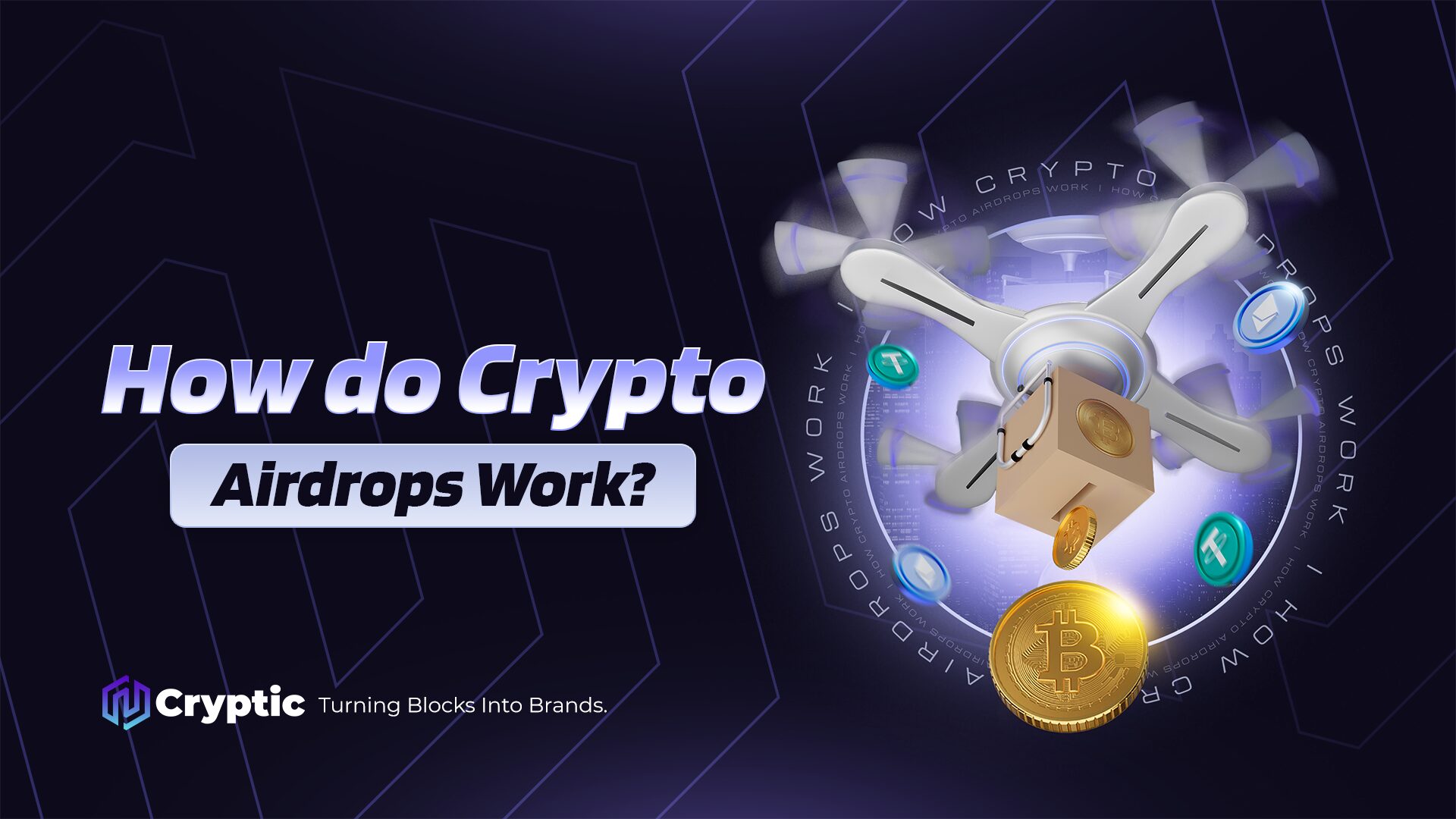In the world of cryptocurrencies, airdrops stand out as a smart way to distribute free tokens, engage communities, and boost the adoption of new blockchain projects. Discover how crypto airdrops work, why they’re so popular with startups, and how you can get involved to unlock new opportunities in the crypto space.

What is a Crypto Airdrop?
A crypto airdrop is a promotional activity where blockchain projects distribute free tokens or coins directly to users’ wallets. This distribution typically targets early adopters, active community members, or specific groups to incentivize engagement and broaden the token’s reach. By offering these digital assets at no cost, projects aim to create awareness and foster initial interest in their platform.
The term “airdrop” draws inspiration from the physical act of dropping supplies from aircraft to recipients on the ground. Similarly, in the crypto space, tokens are “dropped” from the project’s wallet into users’ digital wallets. This analogy helps convey the idea of a sudden and widespread distribution intended to deliver resources quickly and efficiently.
The primary goal of crypto airdrops is to accelerate adoption and enhance liquidity for the new token. By distributing tokens to a broad base of users, projects encourage community participation, which can be vital for building network effects and driving real-world utility. This strategy also helps create a more decentralized token distribution, reducing concentration risks.
While airdrops are generally free, the question often arises: “Are airdrops always without cost?” Most airdrops do not require recipients to pay money; however, some may require users to perform specific tasks such as staking tokens, trading, or participating in governance. Additionally, since transactions occur on blockchain networks, users might need to pay small transaction fees, commonly known as gas fees, to claim or receive the tokens.
Airdrops as a Growth Tool
Free token distributions help blockchain projects gain visibility, attract early adopters and build strong communities without needing upfront investments like ICOs.
This strategy distributes digital tokens for free to specific wallets, helping promote the project, increase token awareness, and drive initial adoption in the market.
Blockchain startups use airdrops as an effective marketing tactic to boost engagement, expand their user base and incentivize token circulation.
Unlike Initial Coin Offerings (ICOs), which require a direct financial investment to acquire tokens, airdrops give away assets at no cost or in exchange for simple actions, without needing upfront funding from participants.
How does a crypto airdrop work?
Crypto airdrops usually follow a step-by-step process:
- Announcement and rules: The project communicates the airdrop details and eligibility criteria through its official channels, such as website, social media, or community forums.
- Snapshot: At a predetermined date and time, the project takes a snapshot of the blockchain to record wallets that meet the eligibility requirements, such as holding a specific token or completing certain actions.
- Eligibility verification: The project verifies the list of qualifying participants based on the snapshot and other criteria.
- Token distribution: Tokens are sent to eligible wallets either automatically or through a manual claim process, depending on the project’s design.
- Smart contracts: Often, smart contracts facilitate the distribution to ensure transparency, security, and automation.
Do I need to pay anything to receive an airdrop?
While the airdrop tokens themselves are usually free, users may need to pay blockchain transaction fees (known as gas fees) to receive or move their tokens. These fees vary depending on the blockchain network used.
Types of crypto airdrops
- Standard airdrop: Simply register your wallet address to receive tokens. Usually requires no additional action.
- Bounty airdrop: Complete specific promotional tasks such as sharing posts, joining communities, or referring others to qualify.
- Holder airdrop: Receive tokens based on holding a minimum amount of a specific token in your wallet.
- Exclusive airdrop: Tokens distributed to specially selected participants, such as DAO members or highly active community contributors.
- Raffle airdrop: Tokens awarded via a random draw among eligible participants.
- NFT airdrop: Receive additional tokens as a reward for holding specific NFTs.
How to Identify Airdrop Opportunities
Identifying opportunities for crypto airdrops requires staying connected to the right channels. Official project websites, Discord servers, Telegram groups, and social media platforms like X are the primary sources where airdrops are announced and promoted. Following these channels closely helps enthusiasts catch new opportunities as soon as they are revealed.
There are some common signs that indicate a project might be preparing an airdrop. Projects without an existing token, those currently in a testnet phase, or those implementing point-based reward systems often hint at upcoming airdrops. Monitoring these signals can give users an early advantage in qualifying for airdrops.
If you’re wondering how to know when a new airdrop is coming, the best approach is to regularly follow official communication channels, subscribe to trusted newsletters, and participate in active crypto communities. Keeping an eye on social buzz and developer updates can also be valuable indicators of a potential airdrop on the horizon.
Earnings from crypto airdrops
Crypto airdrops can offer multiple avenues for potential earnings. The most straightforward approach is selling the tokens once they become available on exchanges, allowing recipients to capitalize on market demand and generate immediate returns. Alternatively, many holders choose to keep their tokens as a long-term investment, anticipating that the project will grow in value and the tokens will appreciate over time. Beyond trading, airdropped tokens often carry utility within their respective ecosystems, such as staking to earn additional rewards or participating in decentralized governance, which can influence key project decisions and add another layer of value.
However, it is crucial to approach airdrops with caution, as not all tokens distributed are valuable or liquid. Some airdrops may have little to no market demand, making it difficult or impossible to convert tokens into real profits. Additionally, the hype around airdrops can attract low-quality projects or even scams, so comprehensive research and due diligence are essential before engaging with any airdrop. In short, while crypto airdrops can be lucrative, they are not guaranteed sources of profit and should be treated as one part of a broader investment strategy.
Differences between airdrops and ICOs
Initial Coin Offerings (ICOs) and crypto airdrops serve distinct purposes within the blockchain ecosystem, primarily differentiated by their approach to token distribution and target audience. ICOs typically require participants to make a direct financial investment, often purchasing tokens at a discounted rate before they become publicly available, with the goal of raising capital to fund the project’s development. This model predominantly attracts larger investors and venture capitalists who are motivated by the prospect of significant financial returns and are willing to assume the associated risks. On the other hand, crypto airdrops distribute tokens freely to a broad user base, aiming to increase community engagement, enhance token adoption, and build awareness of the project without requiring any monetary commitment from recipients. Airdrops often target smaller investors and active users who may contribute to the ecosystem through participation rather than capital, serving as a marketing strategy to create a wider network effect and foster decentralized ownership. This fundamental difference in funding mechanisms and participant profiles highlights ICOs as primarily fundraising events, whereas airdrops function as promotional campaigns designed to incentivize mass involvement and early engagement in a project.
Advantages and Disadvantages of Crypto Airdrops
Crypto airdrops offer several clear advantages that make them appealing to both projects and participants. Firstly, they are free to receive, providing an accessible entry point for users to engage with new tokens without upfront investment. This free distribution often rewards early adopters and loyal community members, fostering a sense of inclusion and encouraging ongoing participation. Additionally, airdrops serve as effective marketing tools by helping to build and expand vibrant communities around a project, creating wider awareness and network effects that can support the token’s ecosystem growth.
However, airdrops also come with notable disadvantages that users should carefully consider. Many newly airdropped tokens suffer from low initial liquidity, making it difficult to convert them into cash or other assets promptly. There are also significant security risks, including scams such as pump-and-dump schemes and phishing attacks designed to steal private keys or funds. Furthermore, some airdrops may distribute tokens that never achieve meaningful market value, rendering them practically worthless despite initial excitement. These challenges underscore the importance of due diligence and caution when participating in crypto airdrops.
Risks and scams
Participating in crypto airdrops can be enticing, but it is important to recognize the associated risks and remain vigilant against scams. One of the most common threats are phishing attacks, where scammers create fake websites, social media accounts, or messaging channels that impersonate legitimate projects. These fraudulent platforms often prompt users to connect their wallets or input private information such as seed phrases or private keys, which can result in theft of funds or loss of control over their wallets. Another sophisticated scam known as dusting involves sending minuscule amounts of cryptocurrency to wallets to trace the owners’ transaction habits, potentially leading to targeted attacks or privacy violations.
A frequent scam tactic is the deployment of counterfeit websites that mimic official project portals, requesting users to connect their wallets under the pretense of claiming an airdrop. Once connected, scammers gain access and can drain the wallet of assets. Because blockchain transactions are irreversible, victims often cannot recover lost funds, making prevention crucial. Additionally, some scams entice users to invest in tokens with promises of future airdrops, only to later “rug pull” by dumping tokens and crashing their value, leaving investors with worthless assets.
To protect yourself, always verify the authenticity of websites and social media channels before engaging with an airdrop. Official projects typically announce airdrops through verified channels such as their websites, Discord servers, or Telegram groups, so cross-check information carefully. Never connect your wallet to unknown or unsolicited sites, and never share your seed phrase or private keys with anyone. A good practice is to maintain separate wallets exclusively for receiving airdrops, thereby isolating your primary holdings from potential threats. By adopting these security measures and practicing caution, you can reduce the risk of falling victim to scams while exploring opportunities in the crypto space.
Tax considerations
When participating in crypto airdrops, it’s important to understand the tax implications, as most jurisdictions consider the receipt of airdropped tokens a taxable event. This means that even if you do not sell or convert the tokens immediately, you are generally required to report their fair market value as income at the time you receive them. Many people wonder if they need to report airdrops for tax purposes, and the answer in most cases is yes failure to do so can result in penalties or legal issues.
Additionally, when you eventually sell or exchange the tokens, you must calculate and report any capital gains or losses based on the difference between the sale price and the value originally recognized as income. This can complicate tax filings, especially if you receive multiple airdrops or if the tokens have fluctuated significantly in value. Due to the complexity and variability of tax laws worldwide, consulting a tax professional experienced in cryptocurrency is highly recommended to ensure proper compliance and to optimize your tax strategy.
Real-World Examples
Crypto airdrops have a long and varied history, starting with AuroraCoin in 2014 often cited as the first large-scale experiment. The Icelandic project distributed AUR tokens to the country’s citizens as a bold attempt to create a national cryptocurrency and promote decentralized money. Since then, airdrops have evolved and expanded across countless blockchain ecosystems, with notable examples like Gas DAO, which rewarded Ethereum users who had paid significant gas fees, and OpenDao, which allocated tokens to NFT holders based on their OpenSea trading activity.
Another striking example is El Salvador’s Bitcoin airdrop in 2021. To encourage nationwide Bitcoin adoption, the government credited every citizen who downloaded its official wallet app with a small amount of BTC. In the NFT space, airdrops have become a popular tool to strengthen communities by rewarding holders with new tokens or exclusive assets. These real-world cases illustrate how projects use airdrops to drive adoption, build loyalty, and experiment with novel ways to distribute value in Web3.
Stay Smart About Crypto Airdrops
Crypto airdrops are a powerful blend of marketing, community building, and user rewards. They can open doors to early profits and new projects, but they also come with real risks, from worthless tokens to sophisticated scams. That’s why staying informed is non-negotiable: always research the project, follow official updates, never share your private keys, and double-check every link before connecting your wallet. With a cautious approach, airdrops can be more than just free tokens, they can be a smart way to engage with the future of Web3 safely and strategically.



